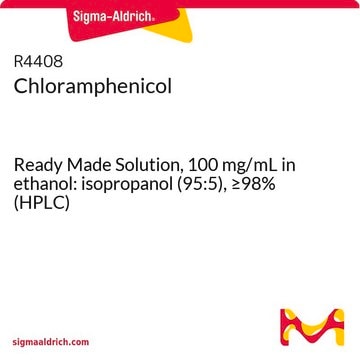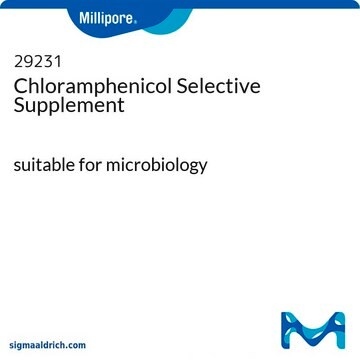C3175
Chloramphenicol-Water Soluble
powder, suitable for cell culture, BioReagent
Sinônimo(s):
Chloramphenicol, Chlornitromycin, Chlorocid, Chloromycetin, Cloramfenicol, D-(−)-threo-2-Dichloroacetamido-1-(4-nitrophenyl)-1,3-propanediol, D-(−)-threo-2,2-Dichloro-N-[β-hydroxy-α-(hydroxymethyl)-β-(4-nitrophenyl)ethyl]acetamide, Chloromycetin, D-threo-2,2-Dichloro-N-[β-hydroxy-α-(hydroxymethyl)-4-nitrophenethyl]aceta, Kloramfenikol
About This Item
Produtos recomendados
product name
Chloramphenicol-Water Soluble, powder, BioReagent, suitable for cell culture
linha de produto
BioReagent
forma
powder
técnica(s)
cell culture | mammalian: suitable
solubilidade
H2O: 50-500 mg/mL (stock solution)
PBS: 50-500 mg/mL (stock solution)
other salt solutions: not recommended
espectro de atividade do antibiótico
Gram-negative bacteria
Gram-positive bacteria
mycobacteria
mycoplasma
Modo de ação
protein synthesis | interferes
Categorias relacionadas
Aplicação
- as a supplement in Luria-Bertani (LB) medium to culture Escherichia coli
- as a supplement in LB agar to culture Citrobacter rodentium
- to culture Toxoplasma gondii
Ações bioquímicas/fisiológicas
Embalagem
Outras notas
Palavra indicadora
Danger
Frases de perigo
Declarações de precaução
Classificações de perigo
Carc. 2 - Eye Dam. 1 - Repr. 2
Código de classe de armazenamento
11 - Combustible Solids
Classe de risco de água (WGK)
WGK 3
Ponto de fulgor (°F)
Not applicable
Ponto de fulgor (°C)
Not applicable
Equipamento de proteção individual
Eyeshields, Gloves, type P2 (EN 143) respirator cartridges
Certificados de análise (COA)
Busque Certificados de análise (COA) digitando o Número do Lote do produto. Os números de lote e remessa podem ser encontrados no rótulo de um produto após a palavra “Lot” ou “Batch”.
Já possui este produto?
Encontre a documentação dos produtos que você adquiriu recentemente na biblioteca de documentos.
Artigos
Antibiotic kill curve is a dose response experiment in which mammalian cells are subjected to increasing amounts of selection antibiotic
Nossa equipe de cientistas tem experiência em todas as áreas de pesquisa, incluindo Life Sciences, ciência de materiais, síntese química, cromatografia, química analítica e muitas outras.
Entre em contato com a assistência técnica







